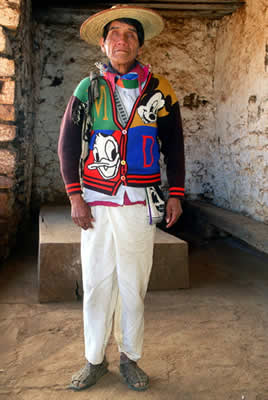The
mission of the Essence of Mexico is two-fold:
I.
To photo document each of the important festivals of the
indigenous cultures of Mexico at the turn of the 21st century,
capturing their aesthetic beauty and their layers of cultural
clues.
The
project was inspired by the work of Carl Lumholz and Edward
Sheriff Curtis, "The Shadowcatcher", who explored
and documented indigenous people in North America a century
ago. The roots of these festivals spring from ancient times
when people began using significant artistic ingenuity to entreat
and therefore interact with the influential deities that held
sway over their lives in the multi-deistic pantheon that emanated
from the agricultural cycle; in hopes of gaining favor in their
struggle for balance and continuity. Moreover, "Festivals
are a work of art, the creation of a magical, mythological
moment when the people can transcend the mundane quality of
their daily lives and drown their sorrows in the intoxication
of a festival day", to quote Eric Wolf. “They are
an essential reaffirmation of the identity of a group as well
as important times of social interaction,” to quote Marta
Turok. During a festival, the celebrants are literally steeped
in the cultural activity that
defines them. In a sense, the culture actually blooms releasing
its essence,"The Essence of Mexico". that
defines them. In a sense, the culture actually blooms releasing
its essence,"The Essence of Mexico".
Many
traditional festivals are at the point of extinction due to
the encroachment of a modern consumerism society. Flowers and
beautifully colored paper traditionally used in the manufacture
of inspired festival ephemera, are being replaced by cheap,
gaudy, store bought, plastic. Young people, potential recipients
of unwritten rituals and traditions, have left their communities
lured away by the promise of a better life constantly extolled
by decades of television. Therefore, it is vitally important
that a comprehensive resource be created from this rare collection
of images of moments of traditional indigenous Mexican artistic
ingenuity, as expressed by the important festivals of their
more than sixty cultures, to preserve their integrity, beauty
and significance for generations to come. The accomplishment
of this goal will grant a kind of permanence to this fascinating
ephemeral art form thereby preserving its cultural clues.
2.
To preserve and share this body of work by creating a detailed
descriptive guide, in narrative form and in a database format,
to provide appropriate access to the archive.
The
collection in its entirety will be housed by the Nettie Lee
Benson Latin American Collection at the University of Texas
at Austin. Additionally, the San Antonio Museum of Art’s,
Nelson A. Rockefeller Center for Latin American Art will preserve
the originals of an elite, aesthetic selection of publishable
images curated from the collection. (The Benson Collection
at UT Austin will receive duplicate images of these selected
originals to be archived by the Rockefeller Center). The images
will be catalogued and correlated with pertinent anthropological
and ethnographic information provided by experts on the depicted
cultures, some of whom accompanied me on some of the photographic
expeditions.
The
Essence of Mexico Collection will serve as an important research
archive for scholars of the Mexican culture by providing a
window to these vestiges of ancient cultural activity and will
be a genesis for future publications and exhibitions. Presenting
the material on an aesthetic level will gain a wider audience
expanding awareness, respect and understanding for people who
are true participants in their landscape and very near to a
place that we have long departed. The Essence of Mexico Collection
is unique in that it encompasses the festivals of these cultures
during the last decade of the 2nd millennium, providing an
opportunity of comparative research during a specific time
frame, as well as a convenient point of reference for future
students of the Mexican culture.
Another
goal of the project is to be able to share the images with
those depicted in order to enhance their own appreciation of
themselves, thereby encouraging continuance of their long,
difficult struggle to maintain their cultural identities. These
goals will be accomplished after the completion of Phase II,
through traveling exhibits, the publication of catalogues,
articles, a series of books and the creation of a website.
A
group of tecuanes, actual gladiators of the central Guerrero
Nahua rain-propitiating festivals. This particular group
will square off against groups from two other barrios in
traditional ritual combat originally staged to reinforce
boundaries as well as experience pain to be propitiated
to the rain god, syncretized with the holy cross. They
are dancing on a Zitlaltepec, the mountaintop that touches
the stars.
|

